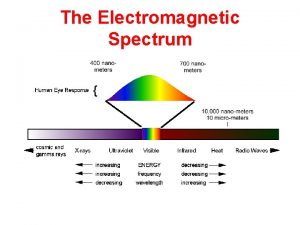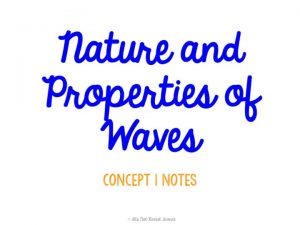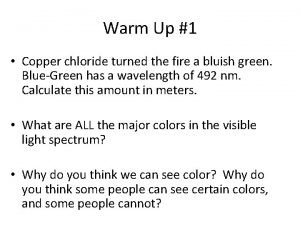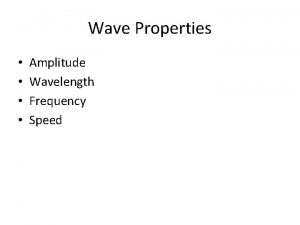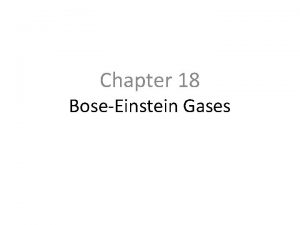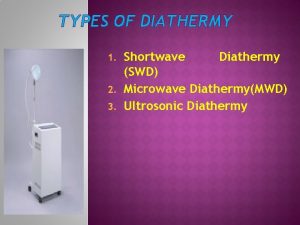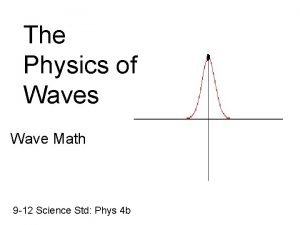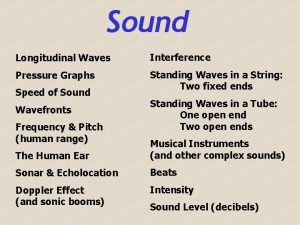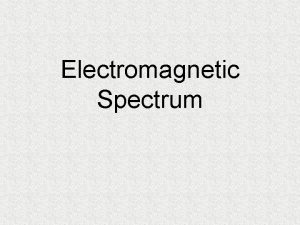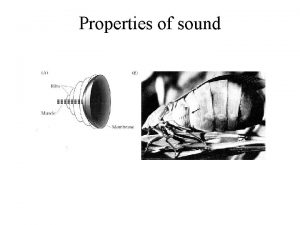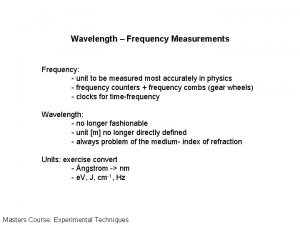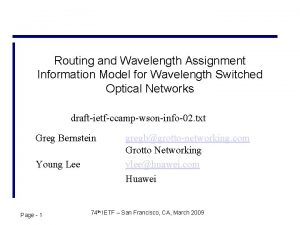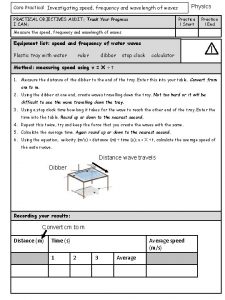Frequency and Wavelength How are frequency wavelength and




































- Slides: 36

Frequency and Wavelength • How are frequency, wavelength, and speed related for electromagnetic radiation in empty space? – speed = frequency x wavelength, where speed is the speed of sound. – speed = frequency/wavelength, were speed is the speed of light. – speed = frequency x wavelength, where speed is the speed of light. – speed = wavelength/frequency, were speed is the speed of sound.

Frequency and Wavelength • How are frequency, wavelength, and speed related for electromagnetic radiation in empty space? – speed = frequency x wavelength, where speed is the speed of sound. – speed = frequency/wavelength, were speed is the speed of light. – speed = frequency x wavelength, where speed is the speed of light. – speed = wavelength/frequency, were speed is the speed of sound.

Bullets • Suppose someone is shooting bullets at you with a machine gun that fires a bullet every 10 seconds. If you run toward the stream of bullets, the frequency at which you get hit will – stay the same – increase – decrease

Bullets • Suppose someone is shooting bullets at you with a machine gun that fires a bullet every 10 seconds. If you run toward the stream of bullets, the frequency at which you get hit will – stay the same – increase – decrease

Photons • Suppose that a star was shooting green photons at you. You measure the time between peaks in the photon wave. If you are moving toward the star, what happens to the time between wave peaks in the photon wave? What will happen to the color you see? – I see the wave peaks more frequently. The photon appears to be more blue. – I see the wave peaks less frequently. The photon appears to be more red. – I see the wave peaks less frequently. The photon appears to be more blue. – I see the wave peaks more frequently. The photon appears to be more red.

Photons • Suppose that a star was shooting green photons at you. You measure the time between peaks in the photon wave. If you are moving toward the star, what happens to the time between wave peaks in the photon wave? What will happen to the color you see? – I see the wave peaks more frequently. The photon appears to be more blue. – I see the wave peaks less frequently. The photon appears to be more red. – I see the wave peaks less frequently. The photon appears to be more blue. – I see the wave peaks more frequently. The photon appears to be more red.

Blackbody approximation • One way of creating a blackbody is to (1) create an empty ball out of iron (2) make its interior rough and (3) drill a small hole in it. If you shoot a photon into the hole, when will it be emitted from hole? • After one reflection. • After a very, very long time. • After two reflections. • After three reflections.

Blackbody approximation • One way of creating a blackbody is to (1) create an empty ball out of iron (2) make its interior rough and (3) drill a small hole in it. If you shoot a photon into the hole, when will it be emitted from hole? • After one reflection. • After a very, very long time. • After two reflections. • After three reflections.

Color and Temperature • Why does an opaque and dense object (such as metal) first glow white before it glows blue when it is heated? – Before the metal glows blue, it emits white photons because this is the emission spectra of that metal at that temperature. – Because the metal is not a perfect blackbody. – Because humans tend to associate cold with blue. – As you heat the metal, its blackbody curve shifts until the peak is at a green wavelength. What humans call white corresponds to the special combination of intensity of green photons along with fewer red and blue photons that the blackbody curve specifies.

Color and Temperature • Why does an opaque and dense object (such as metal) first glow white before it glows blue when it is heated? – Before the metal glows blue, it emits white photons because this is the emission spectra of that metal at that temperature. – Because the metal is not a perfect blackbody. – Because humans tend to associate cold with blue. – As you heat the metal, its blackbody curve shifts until the peak is at a green wavelength. What humans call white corresponds to the special combination of intensity of green photons along with fewer red and blue photons that the blackbody curve specifies.

Spectrum 3 • The image below is the spectrum discussed in class. Suppose Earth's atmosphere contained only nitrogen atoms. What would change? – There would be fewer dips in curve C. The locations of the dips would correspond to the location of the empty spots in the spectra that one would measure of light from a blackbody passed through a cloud of nitrogen gas. – The peak in curve B would be less pronounced. – Curve B would look much more like curve C. – All of the curves would increase in amplitude and their peak location would shift to the left. – All of the curves would increase in amplitude and their peak location would shift to the right.


What will the spectrum look like here?

Absorption Spectrum

Earth’s atmosphere Black lines in absorption line spectrum will appear as low points in Energy Flux curve Count photons per second on absorption line spectrum and translate to Energy Flux.

Spectrum 3 • The image below is the spectrum discussed in class. Suppose Earth's atmosphere contained only nitrogen atoms. What would change? – There would be fewer dips in curve C. The locations of the dips would correspond to the location of the empty spots in the spectra that one would measure of light from a blackbody passed through a cloud of nitrogen gas. – The peak in curve B would be less pronounced. – Curve B would look much more like curve C. – All of the curves would increase in amplitude and their peak location would shift to the left. – All of the curves would increase in amplitude and their peak location would shift to the right.

You ought to be in pictures • How much larger is a raw image of 900 x 900 pixels than one with 300 x 300 pixels? That is, how many more pixels are in the 900 x 900 image? – 9 – 42 – 3 – 27 – 81

You ought to be in pictures • How much larger is a raw image of 900 x 900 pixels than one with 300 x 300 pixels? That is, how many more pixels are in the 900 x 900 image? – 9 – 42 – 3 – 27 – 81

Driving on the lawn • In the following image, what happens to the wheels when they hit the grass, and why? – The wheels turn as in case (a). When the leading wheel hits the grass, it slows down while the trailing wheel keeps at the same speed. While the trailing wheel is on the sidewalk, the axle turns as shown in (a). – The wheels turn as in case (a). When the leading wheel hits the grass, it speeds up while the trailing wheel keeps at the same speed. While the trailing wheel is on the sidewalk, the axle turns as shown in (a). – The wheels turn as in case (c). When the leading wheel hits the grass, it slows down while the trailing wheel keeps at the same speed. While the trailing wheel is on the sidewalk, the axle turns as shown in (c). – The wheels turn as in case (b). When the leading wheel hits the grass, it slows down at the same rate as the trailing wheel. While the trailing wheel is on the sidewalk, the axle turns as shown in (a).


Driving on the lawn • In the following image, what happens to the wheels when they hit the grass, and why? – The wheels turn as in case (a). When the leading wheel hits the grass, it slows down while the trailing wheel keeps at the same speed. While the trailing wheel is on the sidewalk, the axle turns as shown in (a). – The wheels turn as in case (a). When the leading wheel hits the grass, it speeds up while the trailing wheel keeps at the same speed. While the trailing wheel is on the sidewalk, the axle turns as shown in (a). – The wheels turn as in case (c). When the leading wheel hits the grass, it slows down while the trailing wheel keeps at the same speed. While the trailing wheel is on the sidewalk, the axle turns as shown in (c). – The wheels turn as in case (b). When the leading wheel hits the grass, it slows down at the same rate as the trailing wheel. While the trailing wheel is on the sidewalk, the axle turns as shown in (a).

Chromatic aberration • What causes chromatic aberration? – The fact that all electromagnetic radiation travels at the speed of light in a vacuum. – The fact that when a light beam strikes a mirror, it is reflected at the same angle with respect to the normal as its incident angle. – The fact that light at different frequencies bends a different amount when it goes from air into glass. – The fact that each photon has an energy that is given by Plank's Law.

Chromatic aberration • What causes chromatic aberration? – The fact that all electromagnetic radiation travels at the speed of light in a vacuum. – The fact that when a light beam strikes a mirror, it is reflected at the same angle with respect to the normal as its incident angle. – The fact that light at different frequencies bends a different amount when it goes from air into glass. – The fact that each photon has an energy that is given by Plank's Law.

Light bending 2 • If white represents air and blue represents water, which way does the beam go when it enters the water? –A –B –C

Bends toward the normal Dashed line is path of line A if it does not b normal When a light ray goes from air into glass (or water) it bends toward the normal

Light bending 2 • If white represents air and blue represents water, which way does the beam go when it enters the water? –A –B –C

Lens • Suppose you have a single lens from a pair of eyeglasses that is 3 inches in diameter. How many more photons hit this lens per second than would hit a lens that is only 1. 5 inches in diameter? – 4 times – 2 times – 8 times – 16 times

Lens • Suppose you have a single lens from a pair of eyeglasses that is 3 inches in diameter. How many more photons hit this lens per second than would hit a lens that is only 1. 5 inches in diameter? – 4 times – 2 times – 8 times – 16 times

Refraction • When light is incident on a surface, refraction occurs when – it enters the second medium and changes direction. – it “bounces off” at an angle (measured from the normal) equal to the incident angle. – it enters the second medium and changes frequency. – it “bounces off” at an angle (measured from the normal) greater than the incident angle.

Refraction • When light is incident on a surface, refraction occurs when – it enters the second medium and changes direction. – it “bounces off” at an angle (measured from the normal) equal to the incident angle. – it enters the second medium and changes frequency. – it “bounces off” at an angle (measured from the normal) greater than the incident angle.

Telescopes • Why is the Hubble Space Telescope in orbit of Earth? – Maintenance on the telescope is easier to do in Earth orbit than on the Earth’s surface. – To detect X-rays, which cannot penetrate the Earth’s atmosphere. – To get away from human-generated electromagnetic interference. – To eliminate the distorting effect of the Earth’s atmosphere.

Telescopes • Why is the Hubble Space Telescope in orbit of Earth? – Maintenance on the telescope is easier to do in Earth orbit than on the Earth’s surface. – To detect X-rays, which cannot penetrate the Earth’s atmosphere. – To get away from human-generated electromagnetic interference. – To eliminate the distorting effect of the Earth’s atmosphere.

Objective lens • What is the primary purpose of the objective lens in a telescope? – To isolate visible light from other electromagnetic radiation – To magnify the image – To gather light – To correct for chromatic aberration

Objective lens • What is the primary purpose of the objective lens in a telescope? – To isolate visible light from other electromagnetic radiation – To magnify the image – To gather light – To correct for chromatic aberration

Camera lens • Why does a camera with a bigger lens give you a more detailed image? Select the best answer. – More photons are used to create the image. More photons means more detail for the same reason you could draw a more detailed object using many dots versus fewer dots. – Fewer photons are used to create the image. Fewer photons means more detail because there is less interference among photons. – Fewer photons are used to create the image. Fewer photons means more detail because there is less chromatic aberration. – More photons are used to create the image. More photons means more detail because there is less chromatic aberration.

Camera lens • Why does a camera with a bigger lens give you a more detailed image? Select the best answer. – More photons are used to create the image. More photons means more detail for the same reason you could draw a more detailed object using many dots versus fewer dots. – Fewer photons are used to create the image. Fewer photons means more detail because there is less interference among photons. – Fewer photons are used to create the image. Fewer photons means more detail because there is less chromatic aberration. – More photons are used to create the image. More photons means more detail because there is less chromatic aberration.
 Insidan region jh
Insidan region jh Longest wavelength to shortest wavelength
Longest wavelength to shortest wavelength Amplitude wavelength and frequency
Amplitude wavelength and frequency Frequency and wavelength relation
Frequency and wavelength relation Relation between wavelength and frequency
Relation between wavelength and frequency Relation between frequency and wavelength
Relation between frequency and wavelength Wavelength and frequency
Wavelength and frequency How to find wavelength from frequency
How to find wavelength from frequency Transverse wave and longitudinal wave example
Transverse wave and longitudinal wave example Frequency equation wavelength
Frequency equation wavelength Frequency formula in terms of wavelength
Frequency formula in terms of wavelength Diathermy eg microwave
Diathermy eg microwave Em light spectrum
Em light spectrum Relative frequency vs frequency
Relative frequency vs frequency How to calculate relative frequency
How to calculate relative frequency Angular frequency to frequency
Angular frequency to frequency Vmax= aw
Vmax= aw Frequency vs relative frequency
Frequency vs relative frequency Marginal frequency distribution
Marginal frequency distribution Conditional relative frequency distribution
Conditional relative frequency distribution Which color has the shortest wavelength
Which color has the shortest wavelength Transverse standing waves
Transverse standing waves Spaceo wave
Spaceo wave V=fλ triangle
V=fλ triangle Vibgyor wavelength
Vibgyor wavelength Which wave has the lowest frequency
Which wave has the lowest frequency Wavelength formula with length
Wavelength formula with length Precautions of short wave diathermy
Precautions of short wave diathermy Wavelength formula electromagnetic wave
Wavelength formula electromagnetic wave Formula for wavelength
Formula for wavelength Parts of phototherapy
Parts of phototherapy One full wavelength
One full wavelength Light intensity formula
Light intensity formula Which wave has the shortest wavelength?
Which wave has the shortest wavelength? Internal wave
Internal wave Longest wavelength electromagnetic spectrum
Longest wavelength electromagnetic spectrum Which has the longest wavelength
Which has the longest wavelength

